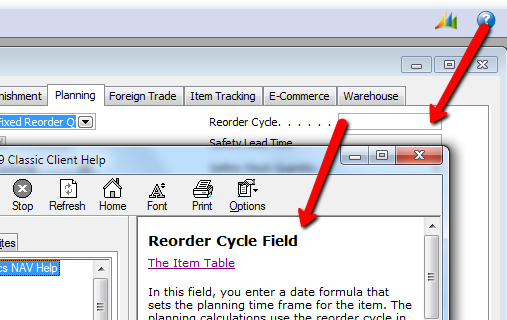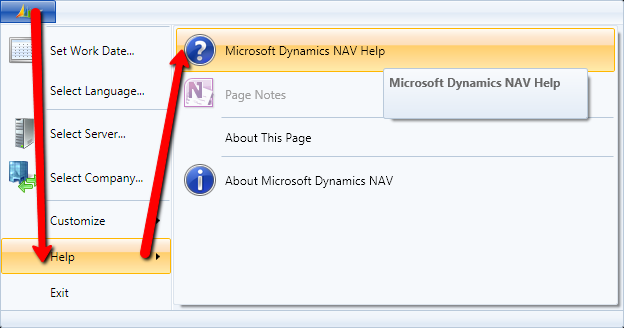Microsoft Dynamics NAV - Finding Help
About This Section
The purpose of this section is to provide a collection of necessary resources for understanding and working with Microsoft Dynamics NAV and for locating knowledge and assistance when problems occur.
Help In The NAV
When you work in Microsoft Dynamics NAV, you can use built-in Help. Using NAV Help is different from the NAV version.
NAV with Classic Client
When you use NAV in older versions, you can find Help on few ways. You can find Help using 'Help' from menu and you can choose some of the next choice:
- Microsoft Dynamics NAV Classic Help gives you a table of contents for the Help system. You can choose Help for different subjects here.
- C/SIDE Reference Guide opens the Help system for programmers. You can find Help on functions, triggers, data types and properties.
- What's This? transforms the cursor to a Help cursor that can retrieve Help for everything on the window.
- Overview of F Keys displays an overview of the function keys in the program. (The function keys appear in a row at the top of your keyboard. You can use them instead of the function menus in the program.)
You can also use other helps through software using. These are next cases:
The F1 Key
When you press the F1 key, you get specific Help for the part of the program where you have placed the cursor. For example, if the cursor is in the Name field of the Customer table, you will get information regarding that specific field and how it relates to the table.
The Help Button in the Window
When you click the Help button, you will see the Help for the window. If there is no Help for the window, the Help for the underlying table, report or batch job is displayed.
The Help Tool Icon
When you click this tool (or 'Help->What's This?'), the cursor becomes a Help cursor. Place the cursor on the part of the window you want help for and click once to open the Help topic.The Help cursor will become an ordinary cursor again when the Help is displayed or when you press Esc.

NAV with Role Tailored Client
The goal of Help for Microsoft Dynamics NAV is to provide information that you can access quickly and efficiently. The Help consists of different types of information that can be accessed in several different ways, as described in the following sections.
Types of Help Information
Business Process Help
The Help contains business process topics that build on a strong foundation of existing information.These business process topics provide the following:
- Context for the process being described.
- Overview information about the process.
- Navigation links to the tasks that support the process.
The goal of the business process topics is to help you gain an understanding of the processes that affect your work, and the various tasks that make up those processes. While these topics cannot capture every company's work model, they attempt to illustrate general concepts around the processes and Microsoft Dynamics NAV best practices.
In addition, the Help contains walkthrough topics. These are end-to-end processes that consist of two or more tasks. By using the CRONUS International Ltd. demonstration database, the walkthrough tasks enable you to learn the steps involved in processes before you perform them using your own data. Application walkthroughs provide the beginning-to-end steps for processes like tracking sales campaign results, or calculating work in process for a job.
Reference Help
Wherever you are working in Microsoft Dynamics NAV, you can get context-sensitive Help that describes the part of Microsoft Dynamics NAV that you are working in. For example:
- To get Help for filling in a field, choose the field and press F1.
- To see a description of the current page or window, choose the Help button in the window.
Sometimes, the context-sensitive Help will describe the database table that contains the data that is displayed in the window. The data that you enter in Microsoft Dynamics NAV is stored in tables. The information in a single table can be displayed in various windows. If there is no Help for the active window or page, Help for the underlying table is displayed.
You can also access Help for tables from the table of contents, from the index, or by using Microsoft Dynamics NAV Help Search.
Task Help
Help contains the following types of topics to help you with your common tasks:
- Procedural Help, which gives you step-by-step instructions to complete a task, such as, how to post an invoice or how to set up a customer card.
- Conceptual Help, which gives you background information about an area of functionality in Microsoft Dynamics NAV.
You can access conceptual, procedural, and business process Help from the table of contents, from the index, or by using Search. You can also find many of these topics in the See Also section of Help topics.
Accessing Help
There are several ways to access Help information in Microsoft Dynamics NAV.
F1 Key
When you press the F1 key, you get Help that pertains to where you have positioned the pointer. For example, if the pointer is in the Name field in the **Customer **table, you will get information about that specific field and how it relates to the table.
Specifics in NAV2009
The Help menu contains two items:
Microsoft Dynamics NAV Help opens a topic related to the window or page that you are working in.
About Microsoft Dynamics NAV displays product information, including the version number of the program.
Specifics in NAV2013
You can locate the Help options on Application menu. The Help menu contains the following options:
- Microsoft Dynamics NAV Help opens a topic related to the window or page that you are working in.
- Page Notes opens the OneNote page that has been shared across a company.
- About This Page provides information about all fields and values that are in the table on which a table or report is based.

OneNote
With Microsoft OneNote 2010 integration you can attach notes to customers, items, or invoices. OneNote notes can be created for a specific record, but also for a whole page depending on the setup. You can attach notes, reminders, or pictures to a specific record such as a customer. You can also create a note attached to a whole page, so there are separate instructions about how to deal with customers, items, or journals.
Specifics in NAV2013R2
In Microsoft Dynamics NAV 2013 R2, there is a new help system. We have not standard help in application. Now, we have something new - Help Server. Help Server is new component of server, but you can call it by all fields in each Client (Windows Client or Web Client). When you run help, you will get information opened in internet browser.
MSDN
You can find many manuals on MSDN. Currently, you can find following:
- Microsoft Dynamics NAV 2015
- Microsoft Dynamics NAV 2013R2
- Microsoft Dynamics NAV 2013
- Microsoft Dynamics NAV 2009R2
- Microsoft Dynamics NAV 2009 Developers and IT Pro Documentations
- Technical Articles
Finding Help From The Community
Forums
You can find many Microsoft Dynamics NAV forums on web, but following are the most commonly used:
...
Blogs
There are many quality blogs about Microsoft Dynamics NAV. You can find following the most active of them:
- Mibuso Blog list
- MSDynamicsWorld
- Vjeko.com
- Waldo
- Mark Brummel - Microsoft Dynamics NAV Blog
- Totovic NAV Blog
- Dynamics User Group
- NAVUG Events & News
- Confessions of a Dynamics NAV Consultants
- Totovic NAV4Construction
- Mohana's Dynamics NAV Blog
- ArcherPoint
- Magno's Blog
- Microsoft Dynamics NAV Team
- Dynamics NAV Financials
- Microsoft Dynamics NAV Guest Columnists
- Van Vugt's dynamiXs
- EDI Integration forMicrosoft Dynamics NAV
- NAV4Construction
- Blog de Microsoft Dynamics NAV by Miguel Llorca
- NAV4U
- ...
How Do I?
Microsoft and Plataan made one of the biggest video projects about some ERP solution. They prepared an excellent video series in collaboration with many MVPs and MCTs. You can find a lot of 'How-Do-I' videos about Microsoft Dynamics NAV on MSDN and YouTube:
- Microsoft Dynamics NAV 2015
- Microsoft Dynamics NAV 2013 R2
- Microsoft Dynamics NAV 2013
- Microsoft Dynamics NAV 2009
You can also find Get Ready for Microsoft Dynamics NAV on Partner Source. Also, you can find video courses for on-line learning here. All "How Do I" video series is specially for partners on Partner Sopurce aranged in six buckets with cohesion between them. These are following buckets:
Finding Help On The Social Network
If you want to follow news about Microsoft Dynamics NAV on Twitter, you can use #MSDYNNAV or #NAVUG hashtags. You can also use #MSDYNERP (common Microsoft Dynamics ERP news) and #MSDYNCOMM (Microsoft Dynamics Community).
For specific Microsoft Dynamics NAV versions, there are following hashtags: #NAV2015 #NAV2013R2, #NAV2013, #NAV2009...
You can find many group intended to Microsoft Dynamics NAV. You can try following examples:
- MS Dynamics
- Mibuso Friends
- Microsoft Dynamics Community
- Microsoft Dynamics Partner Community
- MS Dynamics HUB
- Microsoft Dynamics Worldwide
- Microsoft Dynamics NAV Integration Experts
- Microsoft DynamicsNAV Community
- Directions EMEA
- Microsoft Dynamics Consultants
- Microsoft Dynamics
- Microsoft Dynamics Professionals
- Microsoft Dynamics Elite
- Microsoft Dynamics ERP
- ...
